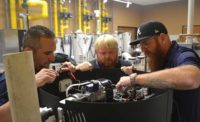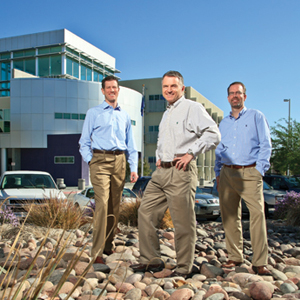
The more intricate the job, the more Las Vegas-basedJBA Consulting Engineersthrives.
The firm, which has offices throughout the world, was in the midst of working on one of the performance theaters on the Las Vegas strip when presented with a unique challenge.
“They came to us halfway through the project and told us about a flame effect that involved taking a ball of gas and shooting it above the audience and then having it explode,” JBA CEODwayne Miller, P.E., says. “And then they asked how do we make it safe? The engineering nerds in us gravitate to these types of projects.”
JBA was founded in 1966 byRalph Joeckel, P.E., a former basketball player at UCLA under the late legendary coachJohn Wooden. Joeckel, at age 83, still comes into the office several times a week. Chairman of the BoardEd Butera, P.E., joined the firm in 1972 and launched JBA into larger, complex projects.
The firm originally focused on mechanical and electrical engineering through the 1970s, ’80s and ’90s and now offers a wide-range of engineering services - including technology and fire and life safety services - from its offices in Las Vegas; Orange County, Calif.; New Orleans; Macau and Shanghai, China; Ho Chi Minh City, Vietnam; and Abu Dhabi and Dubai, United Arab Emirates. JBA’s project scope ranges from mega resorts to airports to varied hospital and medical facilities.
The firm, which Miller reports is enjoying a 20% increase this year in revenue, currently employs 110 technical staff members, including 60 degreed or credentialed individuals. Historically, MEP has been JBA’s dominant revenue stream, but both technology services and fire and life safety work have soared in recent years, especially out of JBA’s Macau office.
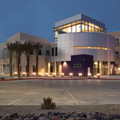
Deep Talent Roster
The firm is able to tackle a wide-range of projects and deliver cost-effective, energy-efficient and operator-friendly results due to the vast experience that dots its roll call of engineering professionals.“It’s really about retaining the talent,” Miller states. “When we list projects like McCarran International Airport (Las Vegas), the Wynn properties, the Mirage, Caesars Palace, the Rio and Aladdin, all the people that did the majority of work on those projects are still part of our organization. Competitors tout project experience, but often the people that did the work are not part of that firm anymore. We work hard to cultivate an experience where people stay.”
That vast amount of experience lends itself to the sharing of ideas in the various JBA offices. Management encourages collaboration through a bullpen workstation arrangement. Miller has a cubicle in the bullpen in the Las Vegas office.
“Everybody is working together and leveraging their technical experience,” Miller says. “If we don’t tap into our collective experience, particularly from people who have been here 20, 30 or 40 years, and leverage into project challenges, we are doing the client a disservice. All of us have different skill sets. If we’re presented with a unique challenge, we can leverage all of our collective experience into creative, cost-effective solutions that make sense over the lifecycle of the building.”
Collaboration starts almost immediately once the firm signs on for a project.
“We’ll start to map out what some of the central systems in a building are and sit down as a group and talk about the different options we may be able to apply,” JBA Vice President of Engineering-AmericasBrad Geinzer, P.E., LEED AP, states. “One person’s idea starts getting improved and we start kicking it around to multiple people. It’s collective reasoning. The group comes up with something even better than what was originally there. We have hundreds of years of experience coming out of one office. We all come from different backgrounds and have not done the same thing. We never quit learning.”
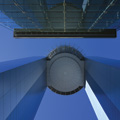
Green Is Not For Show
JBA has been designing energy- and water-efficient designs long before green came into vogue over the past decade.“Sustainable savings were around a long time before LEED became popular,” Geinzer says. “We saw sustainability and energy savings as important in designing buildings a long time ago. It’s always been a core part of our designs. LEED is more of a promotional tool, but the good thing is it has brought more focus to sustainability.”
JBA Las Vegas DirectorRon Edwards, P.E., LEED AP-BD+C, emphasizes following the athletic mainstay of preaching fundamentals can lead to the simplification of sustainability and energy savings in the design of a building.
“I’m happy to see sustainability moving forward,” he states. “But if you look at a LEED-certified building, you can get there and not do too much extra work if you have good engineering and architectural practices. It should not cost much more to become LEED-certified if you are already going in with the idea of a good fundamental building from an architectural and engineering design standpoint. Before green became a buzzword, we were doing buildings 15 years ago that could easily have been LEED-certified because they were built with sound fundamentals.”
Edwards adds working in concert with architects on a project makes the trek to sustainability that much easier.
“The whole team has to buy into the green concepts for it to be a successful project,” he says. “When an architect comes in and understands what it takes to be a green building, that’s when you have success. When you look at energy efficiency, you have to start with the whole system with things such as the building envelope, the roof, the walls and daylighting. You need architect buy-in instead of, ‘OK, Mr. Mechanical Engineer, get me my energy efficiency.’”
A return visit to a property can give Edwards some telltale signs that a project is pointing toward energy efficiency.
“The ultimate successful green project is when you go back to a project a year or two later and it’s being operated the way you designed it. You get the opportunity to take a look at the electrical bills, back-check simulations and see if they happened the way you estimated they would,” he says.
“Just as important as energy efficiency and sustainability is how the building is being operated by the end user. Every building in the country has the ability to save a tremendous amount of energy by operating the way it was designed. Sometimes owners feel systems are too complicated, and they simplify their operations and lives by changing how the systems run. As a result, the systems sometimes use more energy. Keep it simple so the end user can continue to operate the system and maintain what we were driving toward.”
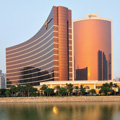
Geothermal and Dry Air
Geothermal has become one of the technologies JBA employs on the road to sustainability. The firm has completed many medium-sized geothermal projects in recent times, including schools and an aquatic center.“In the past 10 years, Las Vegas has started to get into that market,” Edwards explains. “What’s made it viable is many of the drilling companies are coming down from northern areas and that’s allowing the drilling costs to come down.”
Geothermal is a prime sustainable application in Las Vegas due to the area’s dry climate, which allows for the application of a hybrid geothermal system.
“With reduced drilling costs and being in a dry climate, we can install a hybrid system where we reject 40% to 50% heat capacity into the earth and have 50% to 60% heat capacity rejected through a traditional cooling tower process,” Edwards says. “With the dry climate, we’re able to utilize the cooling tower in the evening to recharge the earth temperature. That 40% to 50% capacity can offset heating requirements so we can use the geothermal system in lieu of a boiler system.”
Working On Another Planet
In Yuma, Calif., JBA has designed a government medical facility equipped with a solar domestic hot water system that provides a portion of the hot water load throughout the day at the facility, while reducing the reliance on fossil fuels.“There’s a reason why Yuma is a testing ground for cars,” Geinzer notes. “It’s like another planet with the harsh weather conditions. Temperatures can get to between 110° F and 115° F. We were able to design a lot of energy efficiency in a building that is usually energy intensive in a brutal weather environment.”
The building, awaiting federal financing, received a maximum 10 energy credits on the LEED 2.2 scale from a building efficiency and architecture standpoint. Geinzer calls the design process one of the most enjoyable of his career.
“We were able to integrate sustainable design from the beginning and not fight through the process at the end,” Geinzer says. “The design team was on board with energy savings and sustainability and did it for the sake of sustainability and not solely to achieve LEED certification.”
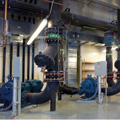
Smoky Savings
JBA has worked on multiple casino projects in Macau in recent years as part of the city’s recent building boom. A problem the firm has run into involves the preponderance of cigarette smoke in the casinos.“The smoking in casinos in China is very intense,” Edwards notes. “To get the design to American standards, our direction on those projects has been to put a balance between the amount of ventilation air being brought in to maintain air quality and meeting energy codes. There are no energy codes in that jurisdiction, but it is good practice to conserve energy when possible and on the owner’s behalf. The energy codes and the indoor air quality goals tend to fight each other.”
One of JBA’s solutions is to exhaust the air that comes out of the facility and utilize heat wheels to dehumidify and cool the incoming outdoor air (usually extremely humid similar to climates in Florida and New Orleans).
“You rotate the wheel with a split at the halfway mark,” Edwards explains. “Air goes across both sides and the wheel rotates. That transfers the energy from the outside air, which is hot and moist, to the exhaust air, which is cooler and dryer. The more outside air you bring in, the more energy recovery you want to do.”
Both Edwards and Geinzer agree these types of projects and innovative solutions constantly fuel their professional drive.
“It’s always fun to re-evaluate with a different set of criteria and discover more efficient ways to do something,” Edwards says.
Geinzer adds: “It’s never the same around here. There is always a unique challenge. Nothing is ever cookie-cutter. It makes the day more interesting.”

